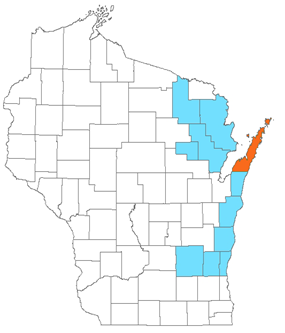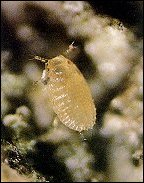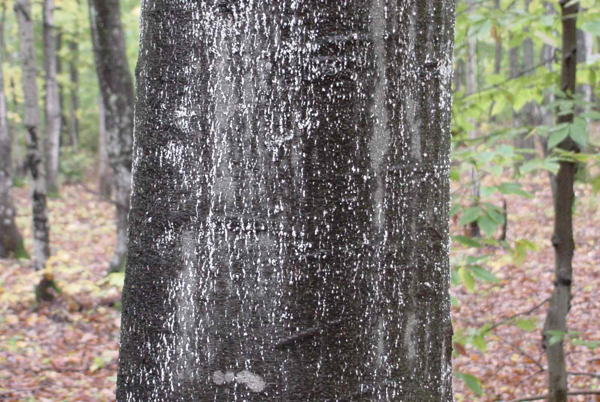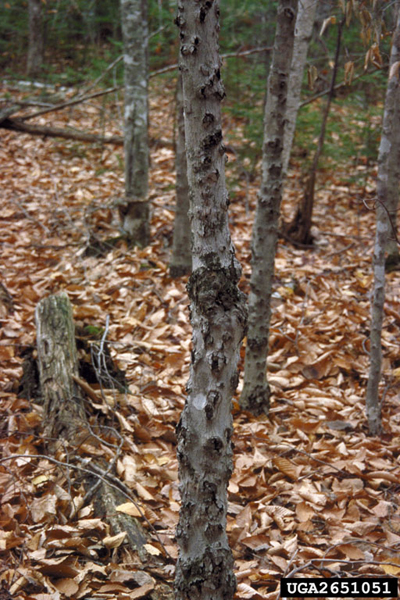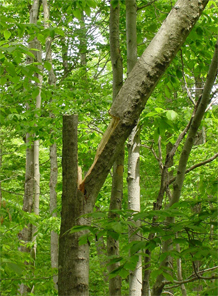Beech Bark Disease
Beech bark disease is a major threat to American beech (Fagus grandifolia) in eastern North America. The disease is the result of an interaction between an insect (a scale) and a fungus (Neonectria) and it only happens when both are present.
Distribution
Beech scale was accidentally introduced from Europe into Nova Scotia, Canada, around 1890. By the 1930s, the scale and an associated Neonectria fungus were found to be killing trees in eastern Canada and Maine. The disease has continued to spread and is now found as far south as Tennessee and North Carolina. It was discovered in Michigan in 2000 and in Door County, Wisconsin, in September 2009.
Wisconsin counties with beech scale or beech bark disease
The beech scale has been found in low populations throughout most of the Wisconsin range of beech. Beech scale is confirmed in 11 counties: Dodge, Door, Forest, Kewaunee, Marinette, Manitowoc, Menominee, Oconto, Ozaukee, Sheboygan and Washington. Mortality due to the Neonectria fungus and high populations of beech scale has only been observed in Door County.
Biology
Beech bark disease occurs when a beech tree is infested with the beech scale, Cryptococcus fagisuga, and then becomes colonized by one of several species of Neonectria fungi. Species impacted include American beech (Fagus grandifolia), European beech (Fagus sylvatica), Chinese beech (Fagus enleriana) and Oriental beech (Fagus orientalis).
Scales
Scales are tiny insects (0.5 to 1 mm) related to aphids. Like aphids, they have a long, tube-like mouthpart called a "stylet" that is inserted into the tree to extract nutrients from the sap. Females reproduce without mating. Adult beech scales lay eggs during the summer; the eggs hatch in the fall. Once the young insects find a suitable location on a beech tree, they insert their stylet into the bark and begin feeding. They lose their legs, become covered with a woolly wax and remain on the bark for the rest of their lives. Scales overwinter this way and become adults in the spring.
Fungal species
Two fungal species work with scale insects to cause beech bark disease. One species (Neonectria ditissima) is a native North American fungus that causes a target canker on weakened hardwoods (a canker is a localized region of dead tissue, often having a sunken appearance). The other fungus, Neonectria faginata, is also believed to be native to North America.
Signs and symptoms
Beech bark disease is in Wisconsin. Look for beech trees covered in white woolly spots. Report suspect trees to the local DNR office or to DNR forest health staff.
A beech infested with beech scale will have scattered woolly spots on the tree trunk. After the scales reproduce, the entire trunk of the tree may be covered in white woolly spots. Scale populations can rise to high levels within only two or three years. Natural movement of the scale is estimated at six miles per year. The immature scales are blown by the wind and are also moved by birds and people. Typically, the scale appears several years before disease symptoms.
After the scale is well established on a tree, fungi get involved. The fungi use the insects' feeding wounds as an entry point into the tree, and as the fungi grow, several disease symptoms appear. The fungus kills the living tissue beneath the outer bark and an orange color can be seen at the front edge of the fungal growth. On some trees a brown sap is produced at dead spots. A canker (area of dead tissue) develops and makes the bark appear rough.
Impact
As the disease first invades a forest, the impact is noticeable because large beech trees usually die within a few years of scale buildup. This first wave of dead trees is called a "killing front."
Cankers may girdle the tree, killing it by cutting off the flow of nutrients; in other cases, the tree may remain alive but disfigured. Other organisms such as decay fungi and wood-boring insects can also invade the diseased trees. These may kill the tree or physically weaken the wood so that the tree breaks during a strong wind.
The loss of beech can dramatically change forest structure and can have a negative impact on many wildlife species because of the loss of nuts for food and loss of nesting habitat for birds. The loss of timber and ornamental trees is another consequence of this disease.
After the killing front passes through, the remaining forest usually contains some surviving large beech and many small beech that have sprouted from the roots of the dead trees. Some of the large trees may be resistant to beech bark disease. The small trees are often disfigured due to the interactions of beech scale, the fungi and another scale insect, Xylococculus betulae.
Management
There are several options for managing beech bark disease.
Killing the scales
Because the disease requires both the insect and fungus, killing the scales will prevent the disease from happening. The scales can be controlled on ornamental beech trees with insecticides, dormant oils and insecticidal soaps. A soft brush or strong stream of water can be used to remove the scales on small trees. In forest stands there is no practical control option other than salvaging dead or diseased trees. In residential or recreational areas, trees weakened by disease are a safety hazard and should be removed because strong winds may cause them to break.
A small percentage of trees are resistant to the scale and do not develop disease symptoms, even in heavily infected stands. Therefore, breeding resistant trees is a possible long-term management option.
Forest planning
Because beech is a very minor component of the overall forest in Wisconsin, there are no special recommendations for its management in preparation for the spread of beech bark disease. However, when marking a stand for thinning during the next regularly scheduled entry, consider beech vigor and bark texture in the order of removal. Typically, this would mean that beech with low vigor and/or rough bark would be harvested. Retain the vigorous trees with smooth bark and keep the stand adequately stocked.
Do not remove all of the beech because some trees are resistant to the disease and will continue to provide wildlife and timber benefits.
Read more in our Beech Bark Disease Fact Sheet [PDF].
Think about the future of the forest
Be aware that emerald ash borer threatens ash, which grow in openings. Thus, encourage other species such as oak, birch, maple or conifers to grow in stand openings through natural or artificial means. Oak and other mast-producing species may be particularly suitable as substitutes for the loss of beech nuts. Also consider the amount of deer browsing when selecting species to regenerate.
When harvesting, try to avoid damaging the root systems of the trees. Beech sprouts in response to root injury and a stand could become more susceptible to beech bark disease in the long term. Also consider the potential for sunscald or other injury to the beech remaining in the stand.
Other things to consider
Financial considerations and management objectives will affect the suitability of these recommendations. Management guidelines may change over time due to changing disease distribution and new research findings. The advice of a professional forester is recommended.
Reasonable precautions to reduce the risk of moving beech scale [PDF].
Other beech issues
While not yet found in Wisconsin, beech leaf disease is killing beech trees in the forests of the Northeastern United States and could be moving toward our state. Learn more about this disease by reading the DNR's newsletter article on the topic or the Forest Service's beech leaf disease pest alert [PDF exit DNR].

